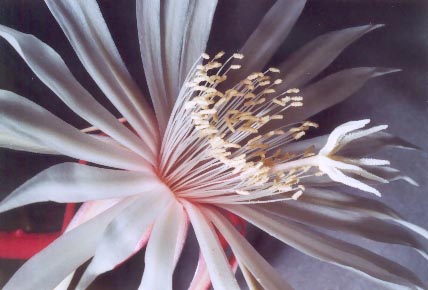Flower EncyclopediaENTER THE WORLD OF FLOWERS |
Other News
Epiphyllum
Category: Cacti
18 Jul : 10:40
To view pictures click on them






 Cactus Family - Cactaceae
Cactus Family - CactaceaeSubfamily Cactoideae
Tribals Hylocereeae
This large genus of cactuses epifitni was introduced in botanical nomenclature Adrian Hardy Haworth in 1812, although the first sketchy descriptions are from the middle of the XVIII century. The name comes from the Greek words "epi" - on, over or "phyllon" - sheet associated with the apparent similarity of the long, broad and flat or trirabi spineless stems, especially in the highlight of their part of the leaves, and this explains the previous name the genus Phyllocactus (Filokaktus). Among the vast amount of plants grown in artificial conditions, because of the splendor of their colors, Epifilumite could easily be put in the forefront. Caused great surprise, how these nondescript, flattened, dissected stalks may unexpectedly show buds that are developing rapidly in large buds, which, after the sunset turn into beautiful colors, amazing in its structure and size.
Have flattened stems that have shaped leaves.
All species have large and beautiful flowers, which open in the evening and lasted several days. They have the most - often form a funnel, often reaching 30 cm blooms the second or third year after rooting.
Beauty to rank epifiluma orchid.
By - popular types are: Epiphyllum oxypetalum, E. phyllanthus, F. crenatum, E. darrahii, E. hookeri and others.
In humid and hot climate of tropical forests Epifilumite evolve rapidly, hung from tree branches to form many air roots. For this Epifilumite often called orchid cactus world. Their kosovidni not large, flexible roots spongy suck the moisture and provide nutrients to the stems. Existing fact sheets appear in the form of small flakes under the areola in the tapered parts of the shoots. Colors are varied in color, large, funievidni, a length of 30 cm diameter and 15 cm long flower tube in most species are dissolved in the night (with the exception of E. crenatum). Their natural habitat extends from Mexico to Paraguay, where they have long cultivated in the tropical forests of Central America and southern Mexico, on separate islands in the Caribbean (West Indies) and in separate locations in Brazil. Epifilumite exact origin is not specified. In the majority of wild species grow as epifitni plants in humid tropical forests, placed in the branches of the branches on the tree bark, in crevices in rocks - everywhere where food environment or natural deposits, next to orchids, bromelievi, mosses and representatives of other tropical flora, but unlike plants harbored, they never eat with the juice of other plants.
Root system is compact, growing to the surface of the substrate layer, withheld pending stems from a fall and feeds them, and air roots, often leaving the stalks themselves, capture moisture from the air and help the stems are held firmly to the projections of the rocks or branches trees and bushes. Epifilumite live in harmony with their neighbors orchids, mosses and bromelievi. While growing should be planted in a food substrate, containing up to 60% by volume leaflet, 20% gravel or gravel, the rest of sealing materials mixed with peat. Gives good results growing these plants in pure sfagnum as flowerpots are irrigated every two weeks with nutrient solution. In closed spaces, they are kept primarily as potted plants. Have to be evenly lit place, the countries of the direct sunlight. At the end of February, the plants begin to grow, but in late spring on stems of flower buds appear. At that time, until the end of flowering Epifilumite be watered thoroughly, should not be allowed stuck in soil moisture. Of flowering in the majority of species and varieties continues from April to June. At that time needs to be watered regularly, be nourished by mineral and organic fertilizers and kept warm and humid place. Not recommended to move or rotate the plants because it is possible to drop off spots. After flowering, the Epifilumite should be given a short rest period (12-15 days), the plants should be allowed to polusyanka and to reduce watering until they begin to see growth stems. Since then, watering should be moderate and not start regularly until autumn cooling. In late October, the plants switched to winter mode, maintaining a temperature within 6.10 degrees and carefully moisten the substrate once a month. At higher temperatures and more frequent watering, growth continues, but the low level of light is formed drooping, withered stems, which is better to remove the spring.
All Epiphyte substrate extremely rapidly exhausted, so should every year to transplant or periodically fertilized. The best time for replanting of Epifilumite the end of the period of flowering. Can reproduce by seed, but vegetative spread is a method of propagation by rooting of cuttings. Epifilumite are easily within species and inter-hybridization. Particularly appreciate the different types of hybrids Disocactus. Feral (pure) species with their white flowers have been preserved only in nature and specialized collections of botanical gardens. To do this color range of hybrids is so rich and includes many hues and shades that have developed a special standard (from the Royal Horticultural Society in England) with a color scale, to put in order and to preserve the nomenclature. In Europe are widely distributed hybrids of these large-flowered plants Tsereusi (generally Hylocereus). As a result of the selection activity, lasting about 150 years have received more than 300 ornamental hybrid forms with large, often fragrant flowers with vibrant colors.
In their morphological characteristics of hybrids Epifilumite be divided into three groups:
1. Herbaceous green stems with flat or trirabi chetinka in the areola. Flowers are open during the day, their color is red to purple, with short flower tube. Obtained are the result of crosses between Epiphyllum ackermanni X Selenicereus grandiflorus.
2. Gray green stems, long, fleshy, flat segments distinct projections and subtle halo. Colors are dark red with a glossy shine. Are obtained as a result of crossing Epiphyllum crenatum X Selenicereus grandiflorus.
3. Dark green segments short and thick, with large bulges and furry halo.
Epifilumite of hybrids as a result of numerous hybrids have gained greater strength and endurance in the cultivation of epifitnite their ancestors.
These cacti grow rapidly.
Use the - well plastic pot with holes to drain. The plant requires a well-draining, rich soil, which is maintained moist during active growth (April - September). It must be a matter of sand, perlite and broken wood.
Be watered thoroughly, but by the end of September, the plant prepares for winter, as irrigation is minimized.
Nurtured during the irrigation from May to August with the regular fertilizer for cacti.
It is better to transplant each year.
Soil:
The preparation of alternative substrates for the cultivation of Epifilum can be used for indoor plants soil, mixed with pumice, gravel, perlite, crushed, bark, avoiding peat-rich soils. Recipe for making something like this:
1 part leaflet
1 part bark of conifers
1 part pine wood cut (6-12 mm. In diameter)
1 part perlite or pumice
Optionally, you can add 1 / 2 part crushed charcoal.
The leaflet can be replaced with an acidic soil (suitable for rhododendron and Azalia). Substrate must contain three parts organic material and one part perlite or pumice. In addition, it can be placed every 30 cubic cm of soil 1 / 2 cup bone brashno.Nay - common pest is mealy bug.
Irrigation:
It is important not to let the substrate to dry completely. Should be watered thoroughly so that water will come from the bottom of the pot. Wait a surface layer of soil to dry before you pour it again. Plastic pots are more appropriate and require less supervision, but must be very careful not to hold excess water in the soil, it can be deadly. Epifilumite grow in spring and autumn, so then they need plenty of water. Period of rest is after flowering and during the winter months, during which time watering is enough to keep the plants slightly moist.
Light:
They prefer filtered sunlight for several hours in the morning or afternoon sun, but never direct sunshine during midday hours. During the winter must be left in a cool but not cold place, it is good to have more light (from household lamps) after sunset. Can be grown and under artificial light from a lamp floristsentna (500-1000 fc) placed at a distance of 25 cm during the time that is illuminated by the lamp must comply with the seasons, it is crucial to the development of buds.
Temperature, humidity, air movement:
Epifilumite prefer temperatures between 8 and 22 degrees, but bear the summer heat if they are in a shady place and kept moist. Withstand temperatures below 0 degrees for several hours, but will die if you leave them for longer in the cold. The plants are damaged at constant temperatures below 5 degrees. Prefer to spend the winter in a protected place at a temperature between 8 and 12 degrees. Fresh winter temperatures and long nights are needed to form buds. The humidity should be at least 50%, but the plants tolerate lower values. Water thoroughly during the hot summer months, remember to keep the air and high humidity with frequent sprinkled. Love to have air movement, but no cold drafts or hot summer winds. Air circulation is promoted, taking away the plants some distance from one another.
Fertilizing:
Plants should fertilize with a balanced 10-10-10 fertilizer, at least once a month from early spring until fall. Can be used as granular fertilizer and liquid. Not exceed the nitrogen phosphorus and potassium in the formula. To support the flowering stems are tender strengthened after the end of winter, making them free moisturizer with Nitrogen fertilizer (0-10-10), once in late February, early March and once in early November. During the winter, not dressed!
Diseases:
Epifilumite rarely attacked by parasites. The most common are mealy bug mealy bug and vlasestata under attack with systemic insecticide spray or a 50% solution of alcohol and water. If kept outdoors in summer can be attacked by snails, which cause enormous damage in a short time.
Replanting:
Replanting is done only on a well-rooted cuttings when observed growth and develop at least 2-3 new stems. The plant is transferred to a pot with a diameter of 20 cm, using a new, dry substrate and not watered for at least one week. Then pour carefully, this continues until one month after transplanting. Transplanting is done in order to procure the plant with fresh new soil nutrients. This will be necessary in 3-4 years if it is fed regularly. Large plants transplant well to at least one month after flowering, unless they developed some root rot or other diseases of the roots.
Flowering:
As a general rule, Epifilumite will blossom in the spring following the second or third year of rooting. To make Epifilumite to blossom, it must be kept at lower temperatures in winter (between 6 and 12 degrees).
Separation of rooted and rooted cuttings:
Use plastic pots with size 8.10 cm per rooted shoot, remember that the roots of Epifiluite should not dry completely. Two cuttings can be planted in the same pot size 20 cm, so the easier it will reach maturity and will zatsaftyat faster. Not planting offshoots of greater depth of 3-5 cm is sufficient to be of depth, as can be held upright self. Place flowerpots in the shade for a week, then move to permanent and place. Water is not at least a week, slightly next month, and regularly thereafter.
Mechanism for planting the rooted cuttings are not the same. Soil should be kept dry or slightly damp, the plants should be in the shade until they root. This will happen after about 2 months if the weather is warm. After roots are formed move the flowerpots in the light. If processes occur rot cut sick part, disinfect, allow to dry completely wound and begin the process again.
| cactaceae haworth epiphyllum |
Comments are turned off for this item0
| cactaceae haworth epiphyllum |























































